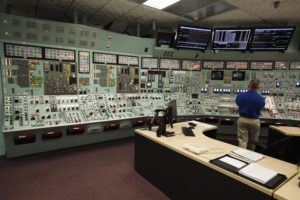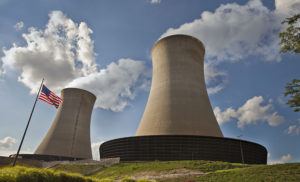Nuclear Power Upgrades

Nuclear power provides 60% of all clean energy sources in America, but this clean power source has slowed in innovation due to public wariness. Exelon Corp has been a global lead in guaranteeing safe nuclear opeartions and digital integration.
Nuclear power has traditionally demanded large quantities of highly trained operators and skilled mechanics to sustain safe operations. The base theory and operations of a nuclear power plant has adapted very little since the 1960’s, but advancements in technology can assist nuclear operators and alleviate some of the manual requirements. Exelon Corporation, the largest nuclear power company in America, is utilizing some new digital innovations to improve their nuclear operations and energy practices.[1]
First, let’s describe a traditional nuclear reactor operator panel, a true relic of the past, the panel is usually as tall as a man and consists of a plethora of buttons, switches, alarm and warning lights, meters and gages, pump and valve indicators, and power level indicators. It is no small feat to be qualified to understand the information the panel provides and to know how to manipulate the panel for nuclear power operations. Transitions from analog to digital has reduced the number of hard wired signals from a valve directly to multiple operator and indication panels, and, instead, the signal can be sent to a main computer system which relays the data appropriately. The reliable computer data and control systems have allowed nuclear operator control panel designs to evolve from analog control to digital control via touch screen panels. (Exhibit 1 and 2)
Exhibit 1: Old Model Control Panel
Exhibit 2: New Model Control Panels
Source: Industry Power Solutions
To compliment the panel operator and ensure safe operations of the nuclear plant, there are engineering operators that adjust and monitor equipment in the engineering spaces. Part of their responsibilities require them to walk through the engineering spaces hourly and record parameter data of vital equipment with pen and paper. This system heavily relied on the operator to notice any abnormal data trends as he walked the spaces checking for any physical abnormalities and performed his maintenance duties. To assist these operators in data analysis, many nuclear plants have shifted from a pen and paper model to tablets. [2] The tablets can record all the data at once, which eliminates the time gap from the beginning of a tour to the end, and it allows the operator to see the all the parameters of a given machine at once. The tablets, also, can relay information to computer systems, and the computers use the data for trend analysis, forecasting, and can identify any abnormalities. The tablets do not reduce the need for operators, but they complement operations, and through data analysis, can be used to reduce down-time.
Controlling power generation and output is most difficult task of nuclear operators. Many variables impact power generation and the system relies heavily on knowledgeable operators for reactor control, and they need to understand their actions for safe operations. The old model of reactor control required the operator to use charts and tables to decide and predict reactor parameters and power levels, but new sophisticated computer models have been developed to aid operators. These models can take large amounts of data, way beyond the capabilities of the original charts and tables, and provide useful predications and recommendations to the reactor operators. Some nuclear plants have combined the data of power levels and plant parameters to analyze casualty situations, as well, and they have use these new capabilities to add automatic casualty control actions.
Exelon recently partnered with GE on the Predix project, which is a software platform designed to maximize performance through data analytics. [3] The goal of this platform is to collect data from all Exelon energy sources (solar, wind, nuclear), analyze the data, and create optimal operating conditions across all of Exelon’s assets. It is difficult to manage power sources and to predict the necessary power level of a nuclear reactor when you are using it to compliment nature/weather based energy sources. This platform would assist operators to predict when to raise nuclear power due to less ideal conditions for wind and solar sources. Predix will provide substantial benefit to Exelon by providing recommendations to maximize their power output and efficiency.[4]
Exelon is succeeding in a business that has faced public wariness and little technological advances in the past three decades. Their devotion to innovation within their nuclear plant operations and energy platforms continues to make them a paramount leader in the industry. Despite these advances in nuclear technology, operators are not ready to relinquish control over to computers; there is still a necessity for the human touch to maintain and monitor all operations, and it is their responsibility to effectively utilize their computer tools.
Source: Exelon Corp
Word Count: 738
[1] Exelon Corp. http://www.exeloncorp.com/
[2] Chicago Business. “Exelon as a Digital Pioneer? Yes, Really” http://www.chicagobusiness.com/article/20150416/ISSUE01/150419921/exelon-as-digital-pioneer-yes-really
[3] Exelon Corp Newroom. “Fortune 100 Energy Company Exelon Chooses GE Predox to Accelerate Digital Transformation” http://www.exeloncorp.com/newsroom/fortune-100-energy-company-exelon-chooses-ge-predix-to-accelerate-digital-transformation
[4] GE Predix. https://www.ge.com/digital/predix






Great post! It seems like absolute madness that so much of the country’s power is generated from nuclear, and that the facilities are so dilapidated and ancient. The only concern that I have with the digitalization of nuclear power plants is the increased threat of losing control of the system – either due to a bug, or bad actors (hackers). Especially after we saw how devastating the Stuxnet virus was to the Iranian nuclear program, it seems like digital innovation can bring massive new efficiencies but also a new series of risks.
As a strong proponent of nuclear technology, I’m heartened to read that Exelon is investing in new technology. But I can’t help but wonder who’s buying. The French–world leaders in nuclear technology–have been struggling to maintain their commitment in the face of budget overruns.[1] California–the U.S. leader in clean energy–just shut down its last nuclear plant this summer.[2] Other American states still investing in nuclear plants have faced major criticism as plans run over budget and behind schedule.[3]
Nuclear is an extremely powerful and (mostly) clean source of energy, and I’d love to see countries invest in the technology, especially if the new digital monitoring systems reduce the safety risks associated with nuclear plants. But given enthusiasm for renewables like wind and solar as well as cheaper (but far dirtier) technologies like natural gas, I can’t help but wonder how much enthusiasm is left for nuclear plant construction.
[1] http://www.nytimes.com/2015/05/08/business/energy-environment/france-nuclear-energy-areva.html
[2] http://www.latimes.com/business/la-fi-diablo-canyon-nuclear-20160621-snap-story.html
[3] http://www.businessinsider.com/americas-new-nuclear-plants-are-costing-billions-more-than-expected-2012-7
I’m also bullish on nuclear. It’s a carbon-free source of base load electricity and I don’t see how we reach our carbon emissions goals without it. To address the capital expenditure problem of developing new nuclear capacity, there is a lot of attention on small modular nuclear reactors. My former company was involved in a project called Generation mPower which was trying to develop a commercially viable SMR. Another promising one is NuScale Power.
Similar to those above, I believe that nuclear has to play a major part in energy production in order to help reduce the climate effects of hydrocarbon power sources. Having spent a decent amount of time in manufacturing facilities it’s crazy to see the differences in modern control rooms and those that haven’t been updated in 50 years. The plant I worked at had a very recently updated control room and the trending technology and predictive nature of the software to improve process efficiency and mitigate crisis scenarios is incredible. I hope (and fully expect) many of the nuclear facilities to update their control systems in the very near future.
Great post!
I share Art’s concern here that digitization of control presents some serious risks in an industry where the magnitude of a negative outcome can be quite significant, potentially threatening the health and well being of a large radius around the plant for many years after an event. Nuclear plants fall high on the target list for malignant actors — in a world where even air gapped systems (e.g., the Iranian centrifuges) are vulnerable to hacking and degradation, I wonder if there are any precautions you could take that would satisfactorily reduce the risk of infiltration and sabotage at a nuclear plant. Even less intentional incidents (e.g., electric power failure in the plant control room) could render a digital control system ineffective for enough time for something bad to happen. Given all of this, I hope this is an industry where there remains robust analog controls that can be leveraged in times of crisis.